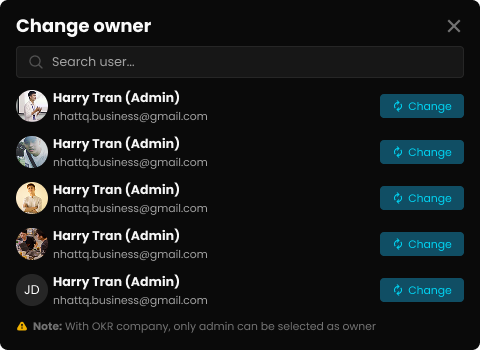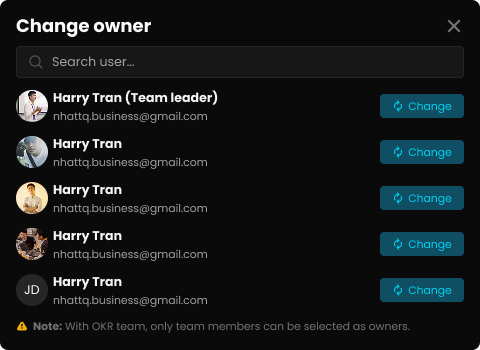Change OKR Owner
Complete guide to changing ownership of OKRs across different levels with proper permissions and best practices
Change OKR Owner
Overview
Changing OKR ownership is a critical management function that ensures accountability and proper assignment of responsibilities. Whether due to organizational changes, role transitions, or strategic realignments, the ability to reassign OKR ownership maintains the integrity and effectiveness of your OKR program.
Understanding OKR Ownership
What is OKR Ownership?
OKR ownership refers to the assignment of responsibility and accountability for achieving specific objectives and key results. The owner is the primary person responsible for:
- Progress Tracking: Regular updates and monitoring
- Strategic Execution: Leading efforts to achieve the objective
- Stakeholder Communication: Reporting progress and challenges
- Resource Coordination: Managing resources needed for success
- Problem Resolution: Addressing blockers and issues
Types of Ownership
Objective Ownership:
- Overall responsibility for the entire objective
- Coordination of all related key results
- Strategic decision-making authority
- Primary point of contact for stakeholders
Key Result Ownership:
- Specific responsibility for individual measurable outcomes
- Tactical execution and progress tracking
- Direct involvement in day-to-day activities
- Reporting to objective owner
Permission System and Access Rights
Company-Level OKR Ownership
For company-level OKRs, ownership changes are restricted to maintain strategic control:

Permissions Required:
- Administrator Role: Only administrators can change company OKR ownership
- Senior Leadership: Typically assigned to C-level executives or VPs
- Strategic Authority: Must have organizational authority to own company goals
Warning Message: "With OKR company, only admin can be selected as owner"
Eligible Owners:
- CEO and C-level executives
- Senior Vice Presidents
- Department heads with admin privileges
- Strategic initiative leaders
Best Practices for Company OKR Ownership:
- Assign to highest responsible executive
- Ensure strategic authority and influence
- Consider succession planning
- Maintain continuity during transitions
Team-Level OKR Ownership
Team-level OKRs offer more flexibility in ownership assignment:

Permissions Required:
- Team Membership: Owner must be a member of the relevant team
- Team Leader Authority: Team leaders can assign ownership
- Administrator Override: Admins can assign any team member
Warning Message: "With OKR team, only team members can be selected as owners"
Eligible Owners:
- Team leaders and managers
- Senior team members with relevant expertise
- Project leads and subject matter experts
- Cross-functional team representatives
Best Practices for Team OKR Ownership:
- Assign based on expertise and capacity
- Consider workload and current responsibilities
- Ensure clear communication with team
- Maintain team alignment and buy-in
Personal-Level OKR Ownership
Personal OKRs typically remain with the individual, but can be reassigned in certain circumstances:
Common Reassignment Scenarios:
- Role changes or promotions
- Team transfers or reorganizations
- Leave of absence or temporary assignments
- Performance management situations
Step-by-Step Owner Change Process
Step 1: Access the Change Owner Interface
- Navigate to OKR Detail: Open the specific OKR you want to modify
- Locate Change Owner Button: Find the "Change owner" option in the header
- Click to Open Dialog: Access the owner selection interface
Step 2: Search and Select New Owner
The owner change dialog provides search functionality to find the right person:
Search Features:
- Name Search: Type the person's name
- Email Search: Search by email address
- Role Filter: Filter by role or department
- Recent Users: Quick access to recently viewed users
User Information Displayed:
- Full Name: Complete name of the potential owner
- Role/Title: Current position and responsibilities
- Email Address: Contact information
- Profile Picture: Visual identification
- Department/Team: Organizational affiliation
Step 3: Validate Selection and Confirm
Before finalizing the ownership change:
Validation Checks:
- Permission Verification: Ensure new owner has appropriate permissions
- Team Membership: Confirm team membership for team-level OKRs
- Workload Assessment: Consider current responsibilities and capacity
- Stakeholder Notification: Plan communication to relevant parties
Confirmation Process:
- Review Selection: Double-check the new owner details
- Click Change Button: Confirm the ownership transfer
- System Update: Automatic notification and record update
- Stakeholder Notification: Inform relevant team members
Common Ownership Change Scenarios
Organizational Restructuring
Scenario: Department reorganization affects OKR ownership Actions Required:
- Review all affected OKRs
- Map new organizational structure
- Reassign ownership based on new roles
- Update team memberships
- Communicate changes to all stakeholders
Best Practices:
- Plan ownership transitions in advance
- Ensure continuity of progress tracking
- Maintain historical records and context
- Provide transition documentation
Role Transitions and Promotions
Scenario: Team member promotion creates ownership gaps Actions Required:
- Identify OKRs requiring new ownership
- Assess capabilities of potential new owners
- Plan knowledge transfer sessions
- Update progress tracking responsibilities
- Adjust timelines if necessary
Transition Checklist:
- Document current progress and status
- Transfer relevant resources and access
- Introduce new owner to stakeholders
- Schedule handover meetings
- Update communication channels
Temporary Assignments and Coverage
Scenario: Owner temporarily unavailable (leave, sabbatical, etc.) Actions Required:
- Identify temporary coverage needs
- Assign interim ownership
- Establish clear timelines for transition back
- Maintain communication with original owner
- Document temporary arrangements
Coverage Guidelines:
- Choose experienced team members for interim ownership
- Provide clear scope and authority boundaries
- Establish regular check-ins with original owner
- Plan for seamless transition back
Performance and Capability Issues
Scenario: Current owner unable to effectively manage OKR Actions Required:
- Assess situation objectively
- Provide additional support and resources
- Consider reassignment if necessary
- Ensure proper documentation
- Follow organizational HR guidelines
Handling Guidelines:
- Focus on OKR success rather than personal issues
- Provide coaching and development opportunities
- Consider workload and capacity constraints
- Maintain professional and supportive approach
Best Practices for Ownership Changes
Pre-Change Planning
Assessment Questions:
- Why is the ownership change necessary?
- Who is the best person to take ownership?
- What permissions and access are required?
- How will the transition be managed?
- What impact will this have on progress and timelines?
Stakeholder Consideration:
- Current and new owners
- Team members and colleagues
- Senior leadership and sponsors
- Cross-functional partners
- External stakeholders
Communication Strategy
Internal Communication:
- Notify current owner of the change
- Inform new owner of responsibilities
- Update team members on new assignments
- Alert senior leadership of changes
- Document rationale and context
External Communication:
- Update stakeholder contact lists
- Revise meeting invitations and calendars
- Modify reporting structures
- Adjust communication channels
- Inform external partners if relevant
Transition Management
Knowledge Transfer:
- Current progress and status
- Historical context and decisions
- Key relationships and contacts
- Resources and tools
- Upcoming milestones and deadlines
Continuity Planning:
- Maintain progress momentum
- Preserve stakeholder relationships
- Continue regular updates and reporting
- Adjust strategies if needed
- Monitor transition effectiveness
Impact on Progress and Reporting
Progress Tracking Continuity
Maintaining Momentum:
- Ensure new owner understands current status
- Transfer progress tracking tools and access
- Maintain regular update schedules
- Continue stakeholder communications
- Preserve measurement methodologies
Adjustment Considerations:
- New owner may bring different perspectives
- Methods and approaches might evolve
- Timeline adjustments may be necessary
- Resource requirements could change
- Stakeholder relationships may shift
Reporting and Analytics
System Updates:
- Ownership records automatically updated
- Progress attribution remains intact
- Historical data preserved
- New owner gains access to analytics
- Reporting permissions updated
Dashboard Changes:
- New owner appears in progress reports
- Notification preferences updated
- Access permissions adjusted
- Team views refreshed
- Historical tracking maintained
Troubleshooting Common Issues
Permission Errors
Problem: Cannot change owner due to insufficient permissions Solutions:
- Verify your role and permissions
- Check team membership requirements
- Contact administrator for elevated access
- Review organizational policies
- Ensure proper approval processes
Team Membership Issues
Problem: Desired owner not showing in team member list Solutions:
- Verify team membership status
- Add person to team before assignment
- Check organizational structure updates
- Confirm active user status
- Review team access permissions
System and Technical Issues
Problem: Change owner function not working Solutions:
- Refresh browser and try again
- Check internet connection stability
- Clear browser cache and cookies
- Try different browser or device
- Contact technical support
Workflow Disruptions
Problem: Ownership change causing confusion or delays Solutions:
- Improve communication planning
- Provide clearer transition documentation
- Schedule proper handover meetings
- Establish interim support structures
- Monitor transition more closely
Next Steps After Ownership Change
Immediate Actions
- Confirm Access: Verify new owner has all necessary permissions
- Update Communications: Revise contact lists and meeting invitations
- Brief Stakeholders: Inform relevant parties of the change
- Transfer Resources: Ensure access to tools and information
- Schedule Check-in: Plan follow-up to ensure smooth transition
Ongoing Monitoring
- Progress Continuity: Ensure OKR progress continues smoothly
- Stakeholder Satisfaction: Monitor feedback from team and partners
- New Owner Performance: Support and guide new owner as needed
- System Functionality: Verify all technical aspects work properly
- Process Improvement: Capture lessons learned for future changes
Related Topics
- View OKR Details - Understanding OKR detail interface
- Manage OKR Actions - Other OKR management functions
- Team Management - Managing team membership and roles
- User Permissions - Understanding access control system
Proper OKR ownership management is essential for maintaining accountability and driving successful outcomes. By following these guidelines and best practices, you can ensure smooth transitions and continued progress toward your organizational goals.
Suggested Related Articles
Create Team-Level OKR
Step-by-step guide to creating effective team-level Objectives and Key Results in AntOKR
OKR Management Overview
Complete guide to navigating and understanding OKR management interface across Company, Team, and Personal levels
View OKR Details
Complete guide to viewing and understanding OKR details across all levels - Company, Team, and Personal
User Management
Complete guide to managing users, roles, permissions, and team assignments in AntOKR
Create Company
Learn how to set up your company profile in AntOKR with step-by-step instructions
Department Management
Complete guide to creating, managing, and organizing departments and teams within your AntOKR organization